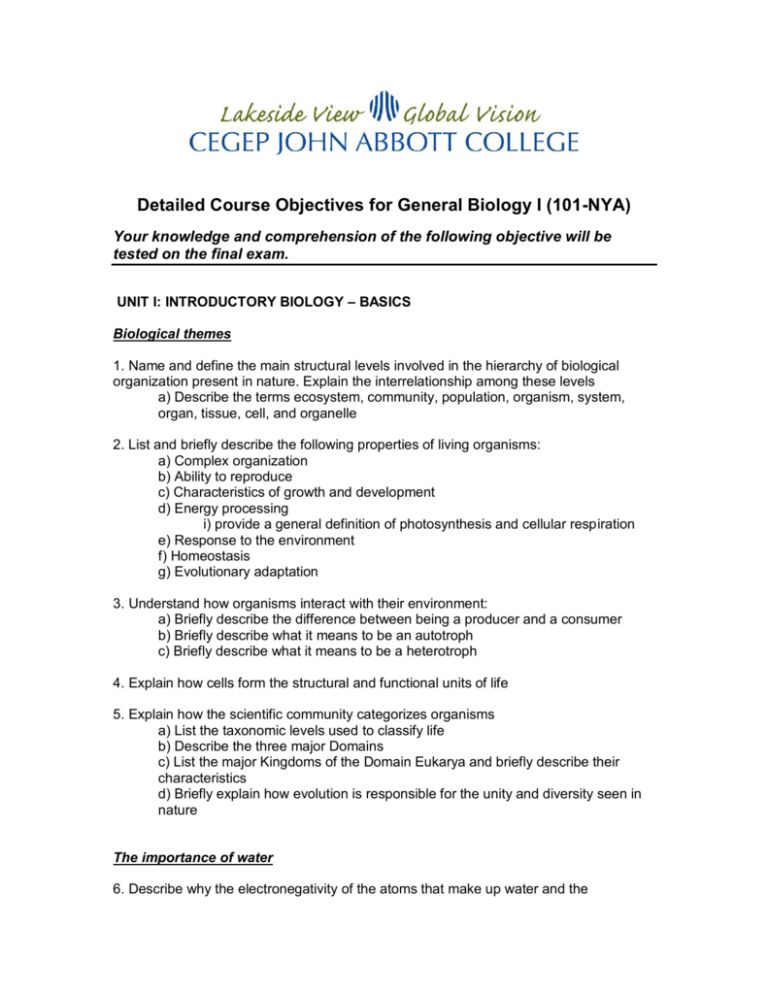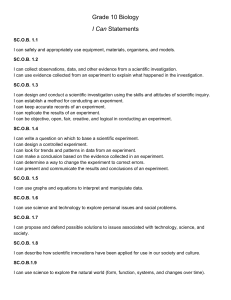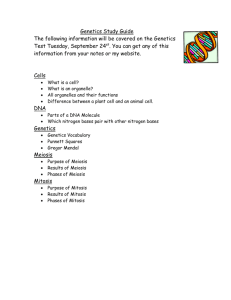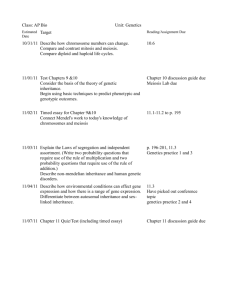Detailed Course Objectives for General Biology I (101-NYA)
advertisement

Detailed Course Objectives for General Biology I (101-NYA) Your knowledge and comprehension of the following objective will be tested on the final exam. UNIT I: INTRODUCTORY BIOLOGY – BASICS Biological themes 1. Name and define the main structural levels involved in the hierarchy of biological organization present in nature. Explain the interrelationship among these levels a) Describe the terms ecosystem, community, population, organism, system, organ, tissue, cell, and organelle 2. List and briefly describe the following properties of living organisms: a) Complex organization b) Ability to reproduce c) Characteristics of growth and development d) Energy processing i) provide a general definition of photosynthesis and cellular respiration e) Response to the environment f) Homeostasis g) Evolutionary adaptation 3. Understand how organisms interact with their environment: a) Briefly describe the difference between being a producer and a consumer b) Briefly describe what it means to be an autotroph c) Briefly describe what it means to be a heterotroph 4. Explain how cells form the structural and functional units of life 5. Explain how the scientific community categorizes organisms a) List the taxonomic levels used to classify life b) Describe the three major Domains c) List the major Kingdoms of the Domain Eukarya and briefly describe their characteristics d) Briefly explain how evolution is responsible for the unity and diversity seen in nature The importance of water 6. Describe why the electronegativity of the atoms that make up water and the asymmetry of the water molecule produce its polarity a) Describe and draw an example of a hydrogen bond 7. List and describe the following properties of water that are important for living systems: a) Water is cohesive b) Water moderates temperature variations (water has a high specific heat) c) Ice is less dense than liquid water (insulation of bodies of water by floating ice) d) Water is the solvent of life Biomolecules 8. List the 6 elements that are most abundant in living matter a) Indicate briefly the role of each of the following elements in living matter: carbon (C), hydrogen (H), oxygen (O), nitrogen (N), phosphorus (P) and sulfur (S) 9. Explain that carbon compounds are the foundation of biomolecules a) Briefly explain the difference between inorganic compounds and organic compounds 10. Recognize that many large molecules are made from a set of small molecules a) Briefly describe monomers and polymers 11. Recognize the basic structure, describe the functions and give examples of the following four major classes of organic molecules: a) Carbohydrates (mono-, di- and polysaccharides) i) explain the function of cellulose, starch, chitin and glycogen b) Lipids: fatty acids (saturated and unsaturated), fats, phospholipids, and steroids i) Explain the significance of the amphiphilic nature of phospholipids for living organisms c) Amino acids and proteins i) List the functions of proteins ii) Explain the term denaturation d) Nucleotides and nucleic acids (DNA and RNA) i) Describe a nucleotide ii) Describe the basic structure and functions of polynucleotides (RNA and DNA) 12. List the main types of biomolecules that make up our diet 13. Explain and give examples of how we use biomolecules for energy conversion (catabolism), synthesis of organic molecules (anabolism) or storage 14. Explain the usefulness of ATP and its production in cellular respiration Structure and function of cells 15. Describe some of the techniques used to study cells 16. Briefly describe the use and functioning of the main types of microscopes commonly used in biology: a) Light microscope / Compound microscope b) Scanning electron microscope c) Transmission electron microscope 17. State the main points of the cell theory 18. Describe the properties of cells 19. Explain the limits on cell size with respect to surface area: volume ratio 20. Distinguish between prokaryotic and eukaryotic cells. Give examples of each 21. Describe the membranes formed by cells a) Describe the fluid mosaic model of a membrane (Singer and Nicholson), including the arrangement of phospholipids, cholesterol, and proteins b) Explain the role of phospholipids in the formation of the bilayer c) Explain the hydrophobic and hydrophilic properties of membranes d) Distinguish between integral and peripheral membrane proteins e) Explain the role of cholesterol in membranes f) Describe the location and role of carbohydrates in membranes g) List the functions of membrane proteins (enzymatic reactions, adhesion, cytoskeletal attachment, reception, transport and cell recognition) 22. Explain the advantages of compartmentalization in a cell 23. Describe the general structure and function of the eukaryotic cell structures and organelles listed below a) Nucleus, nucleolus, and nuclear envelope b) Ribosomes c) Endomembrane system i) endoplasmic reticulum: rough (RER) and smooth (SER) ii) Golgi apparatus iii) Vacuoles and vesicles iv) Lysosomes v) Explain how the components of the endomembrane system are related d) Peroxisomes e) Energy transducers (mitochondria and chloroplasts) i) Briefly explain how mitochondria and chloroplasts transduce energy f) Cytoskeleton i) Describe the role of the cytoskeleton in cell structure and function ii) Describe the function of eukaryotic cilia and flagella iii) Explain cytoplasmic streaming and state the molecules involved in this process iv) Describe the structure and state the functions of centrosomes and centrioles 24. Describe the components of the extracellular matrix in animal cells 25. Describe the structure of chloroplasts, identifying the following components: granum, thylakoid, and stroma 26. Describe the composition and functions of the plant cell wall The flow of genetic information in a eukaryotic cell 27. Explain what complementary base pairing means 28. Describe the double stranded helix of DNA 29. Define the terms chromatin, gene and genome 30. Briefly describe how the process of DNA replication occurs a) State what is meant by semi-conservative replication b) State where and when DNA replication occurs in the eukaryotic cell c) State the function of DNA polymerase 31. Describe the different types of RNA 32. Briefly descibe the process of transcription and state where it occurs in the cell 33. Briefly describe the process of translation and where it occurs in the cell 34. Explain how changes in the DNA sequence can lead to a change in the amino acid sequence of a protein UNIT II – BIOLOGY OF ORGANISMS Diversity of life 1. Describe the characteristics of the 3 domains: Bacteria, Archaea, and Eukarya 2. Describe the prokaryotes (using Bacteria as a model) and compare them to the eukaryotes a) Describe the bacterial capsule, cell wall, ribosomes, flagella, DNA, nucleoid area b) Define the term metabolic pathway and explain the terms anaerobic, aerobic, and facultative c) Give examples of bacteria associated with health, disease and the environment i) Recognize that bacteria are the most diverse, abundant, widespread and functionally important organisms on Earth 3. List and explain the characteristics of the 4 kingdoms (or former kingdoms) of Eukarya. For each kingdom (or former kingdom), give examples of organisms associated with health, disease and the environment a) Kingdom Fungi b) Former kingdom Protista c) Kingdom Planta d) Kingdom Animalia Biology of plants (with Angiosperms as a model) 4. Describe the general differences between vascular and non-vascular plants 5. Identify the major organs of angiosperms and their basic function a) Stems b) Roots c) Leaves 7. Describe amyloplasts Biology of animals (with Humans as a model) 8. Describe the life cycle of animals, using humans as an example 9. Understand the advantage of sexual reproduction 10. Understand the evolutionary implications of internal fertilization The cell cycle and cell division (mitosis and meiosis) 11. State the purpose of cell division and explain the differences between mitosis and meiosis 12. Define the terms: chromosome, chromatin, centromere, chromatid, gene, gamete, centrosome, centrioles, kinetochore, spindle fibers, and aster 13. Describe the sequence of events that occur during each step of the cell cycle a) Describe the appearance of a cell during interphase b) Explain what occurs during the G 1, S and G2 phases of interphase 14. Explain the process and function of mitosis a) State the stages of mitosis and explain what occurs during each stage b) Describe the movement of chromosomes during the stages of mitosis c) Explain the role of microtubules in the movement of chromosomes during mitosis d) Explain why daughter cells produced by mitosis are genetically identical (except for the rare event of a mutation) e) Explain the importance of the cell cycle control system 15. Explain the meaning of cytokinesis a) State when it occurs in the cell cycle b) Describe the process in an animal cell and a plant cell c) Explain how the cell plate forms in plant cells 16. Explain the process of meiosis a) Explain the necessity of meiosis in the life cycle of sexually reproducing organisms b) Explain the meaning of the terms sister chromatids and homologous chromosomes c) Explain the meaning of the terms synapsis, crossing over, chiasma (chiasmata), tetrad, disjunction, non-disjunction and independent assortment of chromosomes d) Explain the processes occurring during meiosis e) Explain the differences between the events of mitosis and those of the first division of meiosis (meiosis I) f) Compare the second division in meiosis (meiosis II) to mitosis g) Compare haploid and diploid cells h) List the sources of genetic variation in the offspring of sexually reproducing organisms i) Briefly explain the differences between males and females in meiosis j) Understand the consequences of non-disjunction in meiosis I and meiosis II i) Explain the consequences of aneuploidy such as Down’s syndrome, Klinefelter’s syndrome and Turner’s syndrome Mendelian and non-Mendelian inheritance 17. Show how the results obtained by Mendel lead to the development of: a) the law of segregation b) the law of independent assortment 18. Explain what is meant by the terms character, trait, gene, allele, locus, mutation, dominant, recessive, true-breeding, genotype, phenotype, homozygous, heterozygous, P generation, F1 and F2 generations, and hybrid generation 19. Construct Punnett squares to determine the possible and most probable distribution of genotypes in offspring for monohybrid and dihybrid crosses 20. Use the rules of probability to calculate the probability of producing specific phenotypes and genotypes from monohybrid and dihybrid crosses 21. Explain what a test cross is and how it can be used to determine a genotype 22. Apply the principles of inheritance to solve problems 23. Describe, with examples, the following inheritance patterns: autosomal recessive, autosomal dominant and sex-linked recessive 24. From a given pedigree, deduce the mode of inheritance (autosomal recessive, autosomal dominant or sex-linked recessive) 25. Describe non-Mendelian inheritance patterns: incomplete dominance, codominance, expressivity, epistasis, multiple alleles, pleiotropy, multifactorial inheritance, polygenic inheritance, sex-linked, sex-limited and sex-influenced inheritance in humans, extranuclear inheritance 26. Discuss the inheritance and clinical importance of the human blood groups and the Rh factor UNIT III – ORIGIN OF LIFE AND EVOLUTION Origin and early evolution of life 1. Define the terms theory and hypothesis 2. Describe how scientists showed that spontaneous generation of life does not occur in the environmental conditions of today 3. Outline the theory of chemosynthetic origin of life and the evidence supporting it a) Abiotic synthesis of organic molecules (Miller and Urey’s experiment) b) Abiotic synthesis of polymers c) Synthesis of protobionts d) Development of self-replicating systems 4. Describe how the evolution of photoautotrophs modified the environmental conditions on the planet 5. Explain the evolution of eukaryotic cells from prokaryotic ones (endosymbiosis theory) Mechanisms of evolution 6. Construct a time-line for the development of the Darwinian theory of evolution, indicating the contributions of: Lyell, Lamarck, Malthus, Darwin & Wallace 7. Explain the Darwinian theory of natural selection 8. Describe and give one example of the following evidence supporting the theory of evolution: a) Fossil record i) Explain relative dating using index fossils and radiocarbon dating ii) Explain why the fossil record of macroevolution is incomplete b) Biogeography: explain how continental drift caused major geographical rearrangements affecting biogeography and evolution c) Comparative anatomy i) Explain the difference between homology produced by adaptive radiation (divergent evolution) and analogy produced by convergence (convergent evolution) ii) Explain the term vestigial structure iii) Comparative embryology: explain the parallels between ontogeny and phylogeny d) Molecular evidence i) Explain how molecular evidence contributes to elucidate the mechanisms of evolution e) Understand how evolution can be observed in action by explaining an example 9. State the causes of microevolution and differentiate from macroevolution 9. Explain the Hardy-Weinberg theorem a) State the conditions that have to exist in order for the Hardy-Weinberg theorem to apply b) Explain why frequencies of alleles may differ from expected values c) apply the Hardy-Weinberg equation to an example of microevolutionary change 10. Explain how the distribution of alleles in a population’s gene pool can be affected by the following agents or processes: genetic drift (founder effect, genetic bottlenecks), gene flow, natural selection 11. State and explain three possible modes of natural selection: a) Stabilizing b) Directional c) Diversifying (disruptive) 12. Define the term speciation a) Differentiate between morphological and biological species b) Explain how genetic isolation maintains the integrity of species c) List and describe pre- and post-zygotic reproductive barriers d) Explain the terms allopatric speciation and sympatric speciation 13. Define phylogeny and phylogenetic tree a) Explain how cladistics is used to generate phylogenetic trees based on common ancestry Evolutionary history of the animals (invertebrates and vertebrates) 14. Describe features shared by all animals 15. Explain the terms segmentation, cephalization, radial and bilateral symmetry, and appendage 16. Identify the following phyla of invertebrates and organize them into a phylogenic tree: a) Calcarea and Silicea (Porifera) b) Cnidarians c) Plathyhelminthes d) Nematodes e) Annelida f) Mollusks g) Arthropods h) Echinodermata 17. Describe the common characteristics of chordates 18. Describe the non-vertebrate sub-phyla of the phylum Chordata: Urochordata, Cephalochordata, Myxini 19. Describe the common characteristics of vertebrates 20. Describe the phylogeny of the extant classes and extinct groups of vertebrates mentioned below, and the relative timing and evolutionary importance of the following steps in the evolutionary history of the vertebrates a) Class Petromyzontida i) Describe how jaws evolved in gnatostomes (Placoderms) ii) State when the mineralized skeleton evolved b) Class Chondrichthyes c) Class Actinopterygii i) State when lungs evolved ii) Describe the term internal fertilization d) Actinistia (Coelacanth) and Dipnoi (Lungfish) i) Recognize features that preceded the evolution of the tetrapod limbs (lobe fins) e) Class Amphibia i) Describe the adaptations amphibians underwent when they moved to land, specifically the tetrapod limbs ii) Explain how respiration takes place in larval and adult forms f) Class Reptilia i) Describe the following adaptations that contributed to the success of reptiles as terrestrial animals: - Impermeable skin - The amniotic egg (define the terms amnion, chorion, allantois, yolk sac, shell) ii) Understand the phylogenetic significance of the fossil Archaeopteryx in reptile and bird evolution iii) Describe the distinguishing features of birds and state their adaptations for flight g) Class Mammalia i) State the features that are unique to members of the class Mammalia ii) Explain the benefits of a heterodont condition iii) Distinguish between monotremes, marsupials and placental mammals iv) State when Homo sapiens appeared UNIT IV – ECOLOGY AND ENVIRONMENTAL BIOLOGY 1. Define the terms: ecology, population, community, habitat, ecosystem, biome, biosphere and niche 2. Describe some abiotic factors (availability of water, nutrients and light, temperature, disturbances, pH) that shape the distribution and abundance of organisms 3. Describe the biotic factors that shape the distribution and abundance of organisms a) Explain what is meant by competition i) Explain the conditions under which intraspecific and interspecific competition occur ii) Give an example of an invasive species that changes the competitive balance iii) Describe Gause’s principle of competitive exclusion by using an example iv) Explain how realized niches differ from fundamental niches b) Explain what is meant by predation i. Explain how aposematic colouration can protect organisms against predators ii. Describe and give examples of Batesian and Mullerian mimicry c) Explain what is meant by parasitism d) Define the terms symbiosis, commensalism and mutualism Population ecology 4. Define the term population ecology 5. Explain what is meant by natality and mortality 6. Explain what is meant by exponential growth of a population 7. State what is meant by carrying capacity and explain how it is determined a) Explain how carrying capacity affects growth rate 8. Discuss the differences between r and K selected strategies 9. Describe and give examples of the three types of survivorship curves 10. Describe human population growth in the past 150 years Community ecology 11. Describe primary and secondary production and productivity a) State what is meant by net primary production (NPP) and gross primary production (GPP) 12. Describe the terms food chain and food web a) Describe the flow of energy in an ecosystem b) Explain what is meant by trophic levels c) Explain why the transfer of material and energy from one trophic level to the next is inefficient d) Give aquatic and terrestrial examples of food chains 13. Describe the top-down and bottom-up controls in food webs 14. Describe how human activity can affect the structure of communities a) Explain how fat-soluble, persistent substances increase in concentration in a food chain (biomagnification) 15. Explain the process of succession a) Define and give an example of primary and secondary succession Biogeochemical cycles and ecosystems 16. Describe the carbon cycle, with an emphasis on its biological components 17. Discuss issues pertaining to global warming (causes, mechanisms and consequences). Discuss the connection to the carbon cycle







